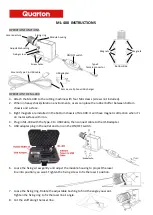
24
Relative water
Content Mode
In addition to displaying volumetric water content
(VWC), the meter can also display the relative wa-
ter content (RWC) and Water Deficit (see MODE
button, p. 8). RWC is an index value calculated
with respect to upper (wet) and lower (dry) VWC
set points. The set points are configured with the
software (refer to Meter Settings, p. 16). An RWC
of 0 indicates the soil is at the dry set point while
an RWC of 100 indicates the soil has reached the
wet set point. (Example: Assume the dry set point
is VWC=25% and the wet set point is VWC=40%.
If the meter measured a VWC of 35%, this would
translate to a RWC of 67 because 35% is 2/3 be-
tween 25% and 40%.) If the soil
’
s volumetric wa-
ter content is outside the range of the set points, it
is possible to get a negative RWC or an RWC
greater than 100.
If the volumetric water contents for field capacity
and permanent wilting point are the wet and dry
set points respectively, the RWC value will be
equivalent to Plant Available Water (PAW). A
general rule of thumb is to recommend irrigation
when the soil has reached 50% of the PAW.
Also included on the first line is the Water Deficit.
The Water Deficit is the amount of rain or irriga-
tion water necessary to raise the soil water content
to the wet set point. This calculation applies to a
soil depth equal to the probe rod length. The water
deficit can be extrapolated further into the profile
RWC=25.5 D=3.17in
A=23.4 N=06 Asnte









































